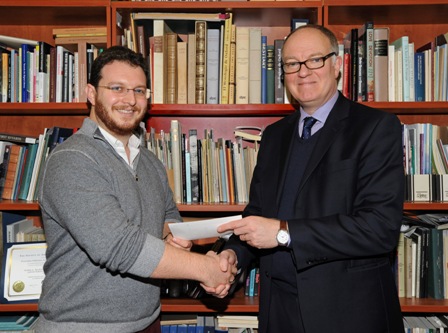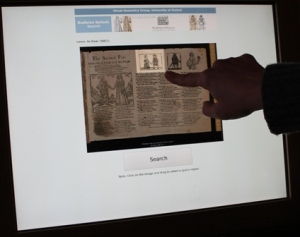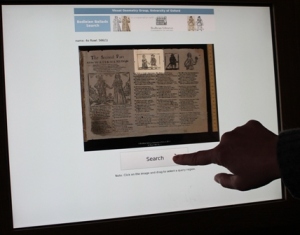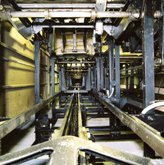To our subscribers, please join The Conveyor at a new address:
http://blogs.bodleian.ox.ac.uk/theconveyor/
Please subscribe at that address using the email subscription form on the right-hand side.
See you there.
See the elaborate, curious, and sometimes sarcastic valentines from the John Johnson Collection, and the blog post this year about Eugène Rimmel (1820–1887).
Of course we know libraries love catalogues, which are useful for so many things. Some recent posts in the ballads.bodleian blog describe the catalogued variants of a broadside ballad sheet containing a song of two constant lovers, the sailor and the farmer’s daughter, who remained true to each other, despite parental objections.

Micha Lazarus (left) with Richard Ovenden, Deputy Librarian, Bodleian Libraries, and Director of the Centre for the Study of the Book
Micha Lazarus (St. John’s) was awarded the Gordon Duff Prize for his essay, ‘Chaekus habet: the circulation of Aristotle’s Poetics in sixteenth-century England’. Richard Ovenden, Deputy Librarian and Director of the Centre for the Study of the Book, presented Dr Lazarus with the prize on 17 January, 2013.
Lazarus surveyed sixteenth- and early seventeenth-century English institutional library catalogues (including Thomas James’s catalogues of the Bodleian) and private booklists, to present an extensive list of owners of the Poetics in the period. One of these was Sir John Cheke, the first Regius Professor of Greek at Cambridge University and tutor to Edward VI; the inscription “Chaekus habet” in a manuscript booklist indicated his ownership of a volume containing the work.
This detailed bibliographical study also casts light on the circulation and modernisation of Aristotelian collections in England. It emerged from Lazarus’s doctoral research, supervised by Professor Richard McCabe, on the subject ‘Aristotle’s Poetics in Renaissance England’.
The Gordon Duff Prize is awarded for an unpublished essay on a subject relating to the science or arts of books and manuscripts. The competition is open to all members of the University. The next prize will be awarded in 2014.
In an exciting conclusion to the autumn season of masterclasses, Felix Waldmann (Cambridge) spoke on ‘James Tyrrell, John Locke, and the text of Patriarcha non Monarcha (1681): the evidence from some Bodleian copies’.
Examining three Bodleian copies, Dr Waldmann found that the pattern of annotations, corrections, and manuscript additions in these copies, from the libraries of Thomas Barlow (the subject of an earlier masterclass) and John Locke himself, contributed significant evidence touching on theories of the composition of the text, which have variously described the publication as a collaboration between Locke and Tyrrell or Tyrrell’s original work which inspired Locke’s Two Treatises of Government.
This was the second in the series of Early Printed Books masterclasses convened by William Poole (New College).
A demonstration of image matching software developed to enable scholars to compare printed images is now running in the Bodleian Library.
Alongside a display of broadside ballads printed in the 17th and 18th centuries is the 21st-century technology that reveals how early modern printers copied woodcut blocks to illustrate different publications.
At a lecture on Tuesday, December 4, in the library’s Convocation House, Giles Bergel (English Faculty) will be joined by Professor Andrew Zisserman and Relja Arandjelovic (Visual Geometry Group, Department of Engineering), to talk about how the software was applied to thousands of items from Bodleian Library collections of printed ballads.
See blogposts about image matching in the Bodleian Ballads blog.
from Tessa Rose, Maps & Rare Books
Sorting through material which surfaced after the decant of Bodleian Special Collections from the New Library,
I came across a box of maps in the Dunston collection. Whilst cataloguing a city plan of Paris I realised that it was signed by the novelist Anthony Trollope.The map is Nouveau plan de la ville de Paris, divisé en 12 arrondissements et 48 quartiers. (1839). It is reasonably large at 59 x 87 cm, but folded into a cover to make it pocket-sized. It is typical of its age and type with a street index and vignettes of Parisian landmarks. The arrondissements are outlined in different colours, but the inaccuracy of the appearance indicates that this was carried out post purchase.
It is not known whether Trollope had the map for his own use as a visitor to the city or to use as reference material for his work La Vendée: An historical novel. His brother, Thomas Adolphus Trollope, also wrote three travel books on France so this map may have come to Anthony that way.


Squaring the circle: a collection of 19th-century mathematical texts by Francesco Cavalli, Bodleian Library Vet. F6 e.173
This volume contains a collection of printed and manuscript items relating to one man’s quest to solve the mathematical problem of squaring the circle. The challenge of constructing a square with the same area as a given circle using ruler and compass and a finite number of steps is an ancient one, but was finally proven to be impossible in 1882.
The collection reveals the author’s obsession with the problem, his apparent solution, and his quest for recognition in a world that appears not to have taken him seriously. Other than a connection with Bergamo, and the suggestion that he is a priest, we have no biographical information about the author, and his name Francesco Cavalli is perhaps a pseudonym, as he also uses “Sacerdos Franciscus de Caballis”, possibly with reference to the physician, astrologer and Professor of Medicine at Padua of the same name, who died in 1540.
The items, many of which are single sheets, or multiple editions of short works, range in date from 1830-1835, and are printed mostly in Milan. The contents vary from verses in Latin about justice, recognition, and truth (relating to the sense of injustice Cavalli expresses at the world ignoring his supposed solution), engraved geometrical diagrams and proofs, to gambling games to be played with dice, and instructive works that emphasize the importance of learning mathematics by practice rather than by theory. The collection also contains manuscript letters to and from the Istituto delle scienze ed arti in Milan, regarding Cavalli’s supposed solution, his request for a prize and recognition, and the Institute’s demands for written proof of the solution. The Institute was not alone in not taking him seriously.
Item (15), written by Cavalli under the pseudonym il Muto dell’Accia al collo di Pavia, records the author’s fall from favour in the preface, and is a sarcastic response to a letter written by a rival during the 1831-32 carnival, perhaps Gli ultimi giorni del Carnovale 1832 a Milano ossia, ecco la mia opinione intorno a tutti gli spettacoli dati alla Scala … : seconda lettera dell’uomo di pietra di Milano al muto dell’accia al collo di Pavia (Milano; Bonfanti, 1832). The response includes scathing verses about the rival with the title “Biografia d’un bevitore” (Biography of a boozer). Item (18) shows Cavalli advertising a public demonstration of his solution, and item (30), which is not by Cavalli, regards a prize offered by the Lombardo-Venetian Kingdom for research into the ill effects on health of air and of drinking water.
Many of the items contain manuscript notes and diagrams, and diagrams and illustrations have been pasted onto blank spaces, including a portrait of a man who is perhaps the earlier Francesco Cavalli. The printed items are not recorded elsewhere, and present some bibliographical problems. The presence of printed wrappers bound with some items cause some confusion over whether particular items are separate bibliographical entities, or parts of larger collected works, where the works enclosed by the wrappers do not correspond exactly with the contents printed on the wrappers themselves. The manuscript items in the collection have been separately electronically catalogued by Western Manuscripts, under the category “Manuscripts in Printed Books”.
COMMITTEE FOR PALAEOGRAPHY/BODLEIAN CENTRE FOR THE STUDY OF THE BOOK
Medieval manuscripts masterclass
In copying late Middle English, as in copying other languages, scribes in fourteenth- and fifteenth-century England drew on techniques long established in practice but seldom written down. Those techniques of the scribes, their collaborators and their readers can be reconstructed from the manuscripts themselves.
These techniques might sometimes have been ‘tacit’, as good as unthinking; but what is intriguing is the question whether correcting ever reflects conscious ‘second thoughts’ about the text corrected and about the process of copying it into a book. Sometimes scribes fix practical problems in scribal labour; sometimes they stop to emend or even collate texts in ways which suggest their reading of, or attitudes to, the language and works they copy. Correcting is thereby a crucial part both of the history of book production and of an interesting period in the history of responses to English language and literature.
Daniel Wakelin came to Oxford in 2011 as Jeremy Griffiths Professor of Medieval English Palaeography in the Faculty of English and a Fellow of St Hilda’s College. He formerly taught in the Faculty of English and Christ’s College in Cambridge.
The class will be held on Monday, 19 November at 2:15 in the Pitt Rivers Museum Lecture Room
Capituli di M. Girolamo Schola sopra varii suggetti, Girolamo Schola, [1540?]
Lawn f.44
A collection of Italian verses on a variety of subjects, including: the hat, gypsies, the goose, the horse, mustard, the cap, and sausages. The date, suggested by the British Museum’s Short-title catalogue of books printed in Italy, is supported by an early manuscript note in this Bodleian copy, which includes the date 1545.

Speculum confessorum et lumen conscientie, Mateo Corradone, Venice, 1538 Bodleian Library, Lawn F.42
This Italian text serves as a guide for confessors, providing them with questions to put to those who come for confession. Each question, or set of questions, for example, “Have you cursed the sky and the stars, sun, and moon?”, is followed either by an instruction – “You have to ask how many times: ten or a hundred, etc., or more or less, etc.” – or by a statement of the seriousness of the sin (for example, “mortal”), together with references to autoritative texts on the matter. The book is held in a re-used Parchment wrapper containing a manuscript document apparently from a widow to her confessor. She asks the confessor to intercede with the bishop on her behalf, in connection with her desire to enter religion.

![Woodcut of Cupid, from Douce Ballads 1(20b) [detail]](https://theconveyor.files.wordpress.com/2013/02/cupid1.jpg?w=497)
![A duck, from Harding B 11(146) [detail]](https://theconveyor.files.wordpress.com/2013/02/harding-b-11146_detail.jpg?w=497)










